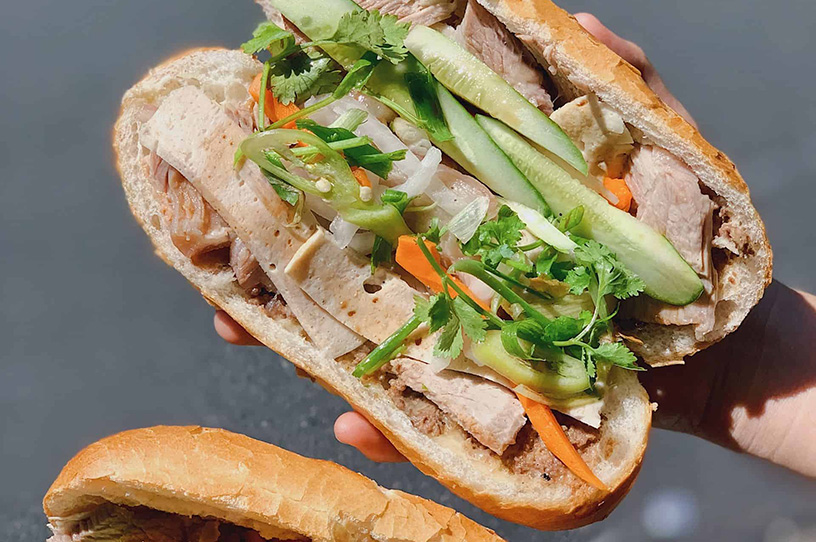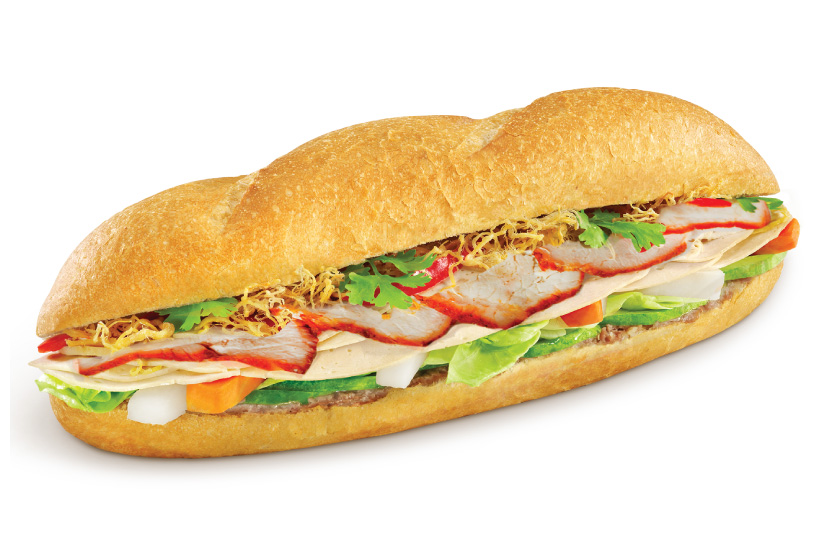Vietnamese Bread (Banh mi) – A famous fast food you should try
Banh mi is a popular street food in Vietnam, and over time, chefs have continuously improved and elevated this dish with various styles of bread. Nowadays, Vietnamese banh mi is not only found in street stalls but also in upscale restaurants. Furthermore, the fame of Vietnamese banh mi has spread worldwide, as many international tourists who come here enjoy and promote this dish when they return to their home countries.
In this article, we will explore more about the types of Vietnamese banh mi and the ingredients used to make this bread.
Read more: The 9 Best Dishes To Eat in Vietnam
Introduction to Vietnamese Banh Mi
Historical Origin of Banh Mi
The basic recipe for banh mi involves mixing flour with water and yeast, then shaping it into various appealing forms. Until now, the origin and timeline of banh mi’s appearance in the world have not been definitively determined. However, there are documents suggesting that bread dates back around 10,000 years, during the Neolithic period when agricultural practices underwent significant transformations. It was during this era that humans began cultivating wheat and using it to make bread.
In Vietnam, banh mi originated from the introduction of the baguette by the French in the early 19th century. The French established the first large-scale bread factories in Vietnam, with the initial establishment located on Paul Bert Street (now Trang Tien Street). Most of the French people who came to Vietnam were not fond of labor-intensive work. Therefore, the bakeries in Vietnam primarily employed Vietnamese or Chinese workers. Under the hands of these bakers, the Vietnamese-style bread loaves, with their distinct characteristics, came into existence. Through the ups and downs of history, banh mi has now become a significant highlight in Vietnamese cuisine.

Vietnamese Banh Mi Recipe
The process of making Vietnamese banh mi is not complicated but rather quite simple. However, to make it delicious, it requires a certain level of finesse. With some skill, you can definitely make it yourself.
Ingredients
To make delicious and authentic Vietnamese banh mi, the choice of ingredients is crucial. Banh mi consists of two parts: the outer crust and the filling.
Outer Crust
The outer crust of the banh mi should be golden, fragrant, and crispy, while the inside should be soft. The crust plays a significant role in determining the overall perfection of an authentic Vietnamese banh mi loaf, which is known for being “crispy on the outside, soft on the inside.”
Filling
This can be considered the soul of a banh mi loaf. The ingredients for the filling can vary depending on different regions, but typically include options such as sausages, roasted pork, fermented pork roll, pâté, cheese, grilled meat with spices, liver pâté, Chinese sausage, grilled pork leg, mackerel fish, fried egg, fish cake, butter, and scallion oil.
The vegetable components can include sliced cucumbers, pickled carrots and daikon, purple onions, garlic, herbs, and chili peppers. Seasonings may include seasoning powder, monosodium glutamate, soy sauce, and fish sauce for making the sauce.
Read more: What makes Vietnamese Bún Chả special?
Sauce: chili sauce, soy sauce, vinegar, sugar, mayonnaise, etc. Generally, most banh mi sandwiches share common components. Notably, the pâté, which is prepared by vendors according to traditional recipes, adds a distinct flavor to the banh mi loaf.

The Steps to Follow
To make a complete Vietnamese banh mi loaf, you only need two steps.
Step 1: Prepare the bread crust and bake it to ensure the crispiness of the bread.
Step 2: Split the loaf in half lengthwise to add the filling. Place some vegetables on top of the main ingredients, then add the desired sauces.
It’s important to mix the filling ingredients just enough to avoid excess spilling out and maintain the aesthetic appeal. The level of spiciness can be adjusted according to individual taste preferences.
Read more: What do international tourists like and dislike when visiting Vietnam?
Vietnamese Banh Mi Worldwide
Alongside the “Ao dai” and “Pho” “Banh mi” has followed the footsteps of the Vietnamese people to many countries around the world and has become one of the symbols of Vietnamese cuisine.
An article titled “The world’s best street food” in The Guardian’s December 2012 issue stated: “A commonly mentioned fact is that the most expensive sandwich today is not found in Rome, Copenhagen, or New York City, but on the streets of Vietnam.”
In 2009, chef Anthony Bourdain in Hoi An, Quang Nam experienced Vietnamese banh mi and commented, “This is truly a symphony of bread.” The image of a Vietnamese banh mi in foreign countries, specifically in the hands of Anthony Bourdain, appeared in the show “No Reservation” on CNN and became famous worldwide.
Other Vietnamese banh mi brands worldwide have also gained recognition, including Saigon Bakery in New York, Bun Mee in San Francisco, and renowned eateries in Taiwan, Hong Kong, and more.
To commemorate the 9th anniversary of banh mi officially appearing on the Oxford map, Google Doodle introduced Vietnamese cuisine with dishes featuring meat, eggs, and pork liver. This milestone recognition demonstrates the worldwide fame of Vietnamese banh mi.

Learn more about: Hoi An Banh Mi: Top 8 Best Banh Mi Shops in Hoi An
Some Types of Vietnamese Banh Mi
An interesting aspect of Vietnamese cuisine is that banh mi is popular throughout the country, but each region has different types of banh mi based on the fillings sandwiched inside:
Meat bread: The most common in Saigon, the filling includes meat, butter, sausage, pate, cold cuts, onions, pickles, and chili.
Xiu Mai Banh Mi: Xiu mai is actually pork in tomato sauce, slightly sweet in Saigon, while in Da Lat, Xiu mai has a spicy taste.
Pork skin bread: This banh mi is filled with thinly sliced pork meat or pork skin, drizzled with a little fish sauce on top, simple yet delicious.
Pilchard fish Banh Mi: Pilchard fish (small fish) in tomato sauce is a tasty combination with banh mi.
Additionally, there are many other types such as beef stew banh mi, char siu (barbecue pork), pate, butter, fried egg, baguette-shaped banh mi, and more. Despite the variations, the taste of Vietnamese banh mi is always delicious, uncomplicated yet crafted from the simplest ingredients.
Several banh mi shops in Hanoi
Hoang Duc Skewered Meat Banh Mi (55 Chua Lang, Dong Da District): The shop is decorated like a miniature version of Hanoi during the subsidy period, which is very interesting. The banh mi here is filled with fragrant skewered grilled meat and accompanied by pickled sweet and sour cucumbers, creating an enticing combination. You can also order additional skewered meat to enjoy with garlic butter on the side if you prefer.
Hai Map Banh Mi (23 Hang Duong, Hoan Kiem District): The filling for their banh mi includes smooth pate, cold cuts, sausages, pork floss, pork belly, fresh egg sauce, char siu, pickled vegetables, soy sauce, cilantro, cucumber, scallions, and green chilies… All these ingredients come together to create an amazing, richly flavored banh mi that leaves a lasting impression.
Dan To Banh Mi (Intersection of Tran Nhat Duat and Cao Thang): The shop starts selling banh mi at 3 am, but customers start lining up from 2:30 am to wait for their turn. The filling for the banh mi is stir-fried evenly in a pan before being added to the bread. Here’s a little secret: eating the banh mi at the shop is the best way to enjoy its deliciousness.
Read more: 15 Top Tourist Attractions in Hanoi
Several banh mi shops in Ho Chi Minh City
Huynh Hoa Banh Mi (26 Le Thi Rieng, District 1): Considered the ‘star’ among banh mi shops, Huynh Hoa Banh Mi is known for its generous amount of meat and cold cuts. With just one bite, you will immediately experience its chewy and uniquely fragrant texture, making it a delightful treat that you can enjoy without getting tired of.
Madam Diep Banh Mi (238 Vo Thanh Trang, Ward 11, Tan Binh District): This bakery has been operating for several decades and is always crowded with customers. A banh mi here is filled with pate, butter, meat, cold cuts, pickled vegetables, and comes at an affordable price.Hoa Ma Banh Mi (53 Cao Thang, Ward 4, District 3): This is one of the earliest banh mi spots in Saigon. The accompanying dishes served at this shop are considered ‘exclusive,’ which is why many people love it.
Read more: 9 Top Tourist Attractions in Ho Chi Minh city
Conclusion
Vietnamese banh mi is a popular and affordable street food that offers a wide variety and regional differences in flavors. If you have the opportunity to visit Vietnam, don’t miss the chance to enjoy the famous banh mi here. Ask your friends or local guides for recommendations on the best places to get delicious banh mi in the area you’re visiting. Wishing you a pleasant trip to Vietnam.
Read more: Expenses for your Vietnam trip


